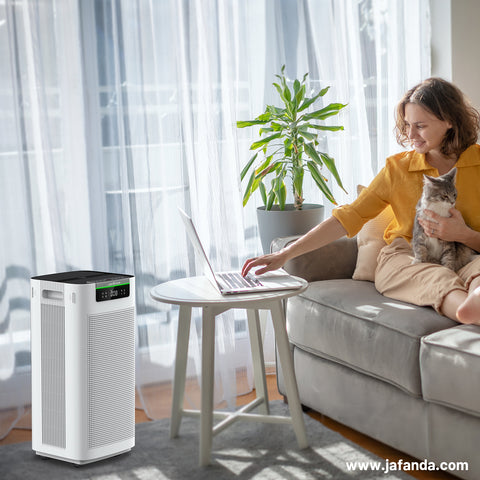As forest fires rage on and smoke engulfs many cities, the deteriorating air quality has raised concerns about dealing with smoke pollution. In this peak season of forest fires, air purifiers have become essential in filtering harmful particles and volatile organic compounds (VOCs) from the air, providing a fresh and healthy indoor environment. However, with various brands and models of air purifiers available in the market, how do you choose the right best air purifier for forest fire smoke to combat pollution from forest fire smoke? Here are some key factors from Jafanda company and guidelines to help you make an informed choice.
Understand the Filtration System: The filtration system is the core component of an air purifier, determining its effectiveness. When dealing with pollution from forest fire smoke, it is crucial to select a purifier with efficient particle and VOC filtration capabilities. Common filtration systems include HEPA filters, activated carbon filters, and pre-filters. HEPA filters capture tiny particles, while activated carbon filters adsorb volatile organic compounds. The combination of both provides comprehensive purification.
Determine the Appropriate Coverage Area: Different air purifiers are suitable for different room or space sizes. When selecting an air purifier, it is important to determine the area you need to cover. Check product specifications and technical parameters to choose an air purifier that suits the size of your home or office space, ensuring effective purification of the entire area.
Pay Attention to CADR Values: Clean Air Delivery Rate (CADR) is an indicator of an air purifier's efficiency in purifying the air, representing the volume of air the purifier can filter per unit of time. When choosing an air purifier, pay attention to CADR values, especially for particles and VOCs. Higher CADR values indicate higher filtration efficiency, allowing the purifier to clean the air more quickly.
Consider Noise Levels: The noise level of an air purifier is also an important consideration. Particularly for nighttime or quiet environments, choosing an air purifier with low noise levels can provide a more comfortable user experience. Before purchasing, check the product's noise level specifications or customer reviews to choose a model that meets your quietness requirements.
Explore Additional Features and Smart Capabilities: Some air purifiers come with additional features and smart capabilities, making them more convenient and intelligent. For example, some purifiers are equipped with air quality monitors that display real-time indoor air quality and remind you when to activate or replace filters. Additionally, some air purifiers offer features such as timer settings, remote control, and smart integration, providing a more personalized and intelligent user experience.
Lastly, purchasing an air purifier from a reliable brand with good after-sales service is crucial. This ensures that you receive a high-quality product and comprehensive support for assistance and maintenance throughout its use.
In conclusion, choosing the right air purifier is a crucial step in protecting yourself and your family from pollution caused by forest fire smoke. By understanding the filtration system, coverage area, CADR values, noise levels, additional features, and smart capabilities, you can make an informed purchase decision, ensuring that your home has fresh and healthy indoor air. Let Jafända air purifiers be your ideal choice, helping you safely navigate through this peak season of forest fires.

